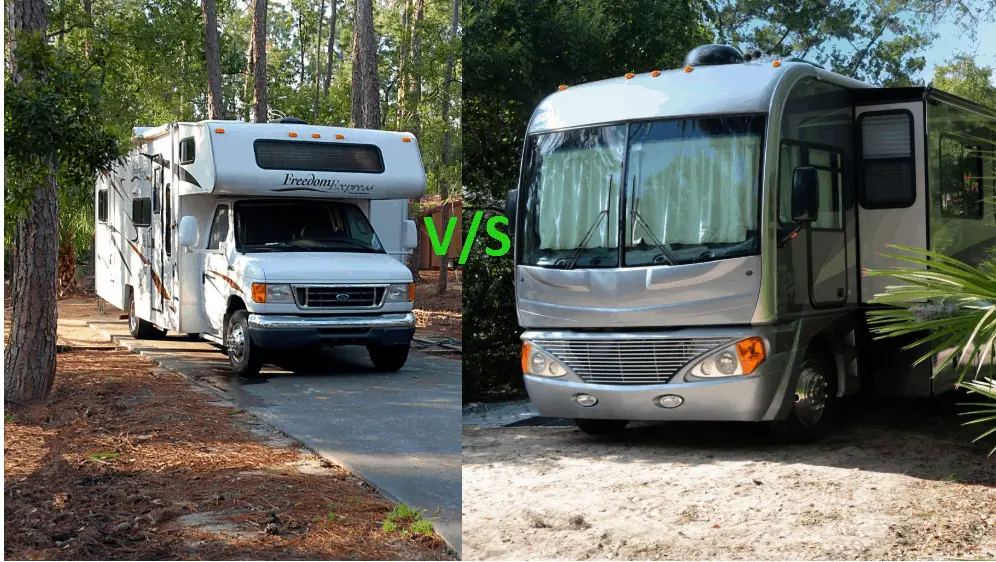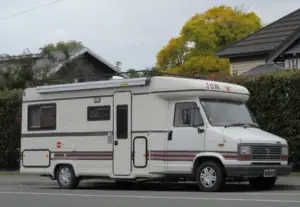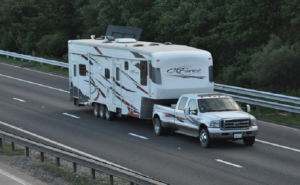Deciding between class A RV or class C RV can be a tough decision. There are so many things in common between them yet you are not sure which one fits your bill.
Its a big decision. Big money. And thus finalizing on one of them is obviously going to be difficult.
This post lists out all the differences, commons, pros and cons between these two mega motorhomes.
| Pros | Cons | |
| Class A | Gives lots of amenities Gives Large Kitchen Perfect fit for Large families They are four-season RVs Luxurious on road vehicle Very high water storage capacity Slide-Outs gives extra space Better floor plans Can tow cars of any sizes easily | They are very expensive. High Insurance Cost Very lengthy and not easy to maneuver Expensive in terms of mileage, insurance and maintenance Special license requirements |
| Class C | Driving class C RV is easier Insurance cost is lower They are affordable as compared to Class A Better fuel economy Gives better floor plans Parking is easier than Class A May not need special license to drive | Storage is lesser as compared to Class A Falls short on amenities and luxury compared to Class A Not all Class C RVs can be used year round |
Remember, each of these motorhomes have their own advantages and disadvantages and thus no single motorhome can be said as the best or worst. It all depends on the usage, needs and available resources.
1. Brand new Class A RV costs much more than Class C RV
Cost of a motorhome is obviously the first factor listed here. Class A rv are costly, no doubt. Lets see the average cost difference between the class C RV and class A RV. When you buy a vehicle that costs so much, its certainly the single most factor that can make all other factors null and void. But, a sensible decision should always be thoughtful.
Cost is important but don’t make this a deciding factor unless its really out of reach. And, if it really was out of reach then there wouldn’t be any comparison at all. A brand new class A RV (popular ones) can be bought in a cost price of between $50,000 to as high as $2,20000. That’s lot. And unless you have millions in your account, you would do thorough research, comparison before going ahead and bringing one home. Talking about class C rv cost, they are on an average priced between 40000 to 85000.
Most popular class C RV would be above 60000 though. As you see the difference, a class A RV on an average is almost double the price. This is a great difference and can be a put down for class A RV. But wait! class A Rv’s are priced so much for a reason and that reason could very well be your priority. The main point of comparison is to set your priorities and match them with the availability. Unless you do not have a budget to go for a class A RV read on, to find what other factors are with class A and what are against.
2. Class C RV Depreciation is lesser as compared to Class A
Motorhomes or any other RV’s depreciate a lot. Once you buy a brand new rv, its value starts getting lesser very quickly. Thus, a model year of the rv matters a lot. Comparing on this factor is important because you don’t want your motorhome value to go down heavily. So, is there any specific % with which both class C and class A rv’s depreciate? Definitely no.
But, can we judge on the basis of previous history of users? may be yes. What we could do is, do a study to see how much on an average both (class A and class C rv’s) loose value over time. Well, both of these rv’s are cut to cut in terms of depreciation percentage. A 5 year old class c RV on an average can be seen as loosing 35% of its value, while same period depreciation for class A rv is almost similar at around 35-40%. Class A rv seems to loose its sheen a little bit more.
A 20 year old class A rv depreciation percentage is at 90%, where as class C rv depreciation stands at 80-85%. Overall, class C is a winner with a very slight margin. The average % depreciation here is totally dependent on lots of factors and will vary a lot.
Did you notice anything? we spoke about cost factor initially and now the depreciation %. So? what we need to read in between lines here?
Buying a second hand class A rv or class c RV could be a great deal ! A 2-3 year old class A rv or class c RV may not depreciate highly, but still it could be a very good deal. Overall, as a deciding factor between class C motorhome and class A motorhome, depreciation should be a factor least in consideration.
3. Class A Motorhome gives little less gas mileage
Class C rv’s in general seem to be giving better mileage as compared to a class A rv. However, the difference is not high. On an average a class A motrhome give a 8-10 miles per gallon, where as class C rv could give you 10 or above miles per gallon. With a 2 miles per gallon difference it wouldn’t be a much pain especially when you own a $50,000 motorhome. But, if you have plans of living full time in a motorhome, then it could be a valid point to pay attention to.
Having said and discussed the difference between the miles per gallon, not all class C rv or class A rv’s will have this kind of mileage. You will always find class c rv’s that give much less mileage too. And, also it depends on lots of other factors too.
4. Length comparison – Class A RV are much lengthier than Class C
Motorhomes are lengthy vehicles on road. A class A rv on an average is around 33 feet long. Where as class C rv’s are little less long and their average length is seen to be around 28 feet long. Such Massive lengthy vehicles can be intimidating. Some of the biggest RV’s are class A and they can be as long s 45 feet or even more.
So ,why do lengths of a motorhome matter?
A long length mean more space for you. But, can you always afford such lengths? So, Should you be worried about how long your RV is ? National parks and campground do not allow lengths that exceed their maximum allowed limit. This can annoy you, if your rv exceeds the limited length of your favorite campsite. So, whats the length limit campsites have? well, different sites will have different limits (its not same for all). But, speaking in terms of average, if your RV is more than 38 feet long than there is a great chance that you may not fit in more than 40% of campsites around the united states.
Analyzing various campgrounds, a length of around 30 feet goes well with most of the parks. Thus, a class A rv may turn out to be a vehicle not allowed in campsites(if you have that longer lengthy one). A class C rv, since has a average length that hovers around 30 feet, there is more chance that you will fit in. Obviously, this are average lengths and you could very well get a class A rv within 35 feet and also a class C rv exceeding 35 feet. Moral of the discussion, double check the length of your motohome when buying.
5. Class A RV’s are little higher in height
Owning a rv means you will have special requirements for garage. Rv’s not only have large lengths, but also have heights that need garage that is much bigger in height. Lets Compare the heights of class A and class C rv. A class C rv on an average can be as 8-10 feet in height, where as a class A rv stands at a height that, on an average is around 10 feet or more.
A 10 feet height rv would need a garage that should be minimum 14 feet in height. Understanding the height of the rv is thus important. A bigger RV would mean you built a garage to fit it in. Comparing both, we see that the heights of both are almost similar and garage requirements are also similar. A more luxurious class A rv however can exceed the height limits and that calls for a thing to note.
6. Class A RV’s are heavier than Class C RV
Class C motorhomes or most often called as mini motorhomes normally weigh less than the bigger class A rv’s. Where as Class A rv’s as expected from their lengths, weigh much more. Motorhome of type class A on an average have weight of 35000 pounds where as class C rv’s on an average can have wight of around 20000-28000 pounds. Remember, the weight depends on the kind of appliances you have in your motorhome and also on the length of the vehicle. A higher end of class C motorhome may very well be heavier than a lower end class A motorhome.
Rv’s or motorhomes are normally built on truck like chassis, which also includes the driver cabin and thus tend to be much more in weight. The type of construction of the RV is also responsible for the weight. Traditionally built motorhomes are seen to be heavier where as new technology and material reduces the overall weight.
Class C rvs can be a good option for those who are new for the RV lifestyle, as they provide better driving because of their weight distribution. Class A rvs are magnanimous as far as their weight is concerned and anybody trying their hand for the first time could be under pressure. With advances in manufacturing, the class C rv’s are getting features closer to what class A rv’s provide. Remember a weight of vehicles above certain limit makes you to take a different license in many states and hence knowing the weight of your motorhome becomes important.
The legal limit could be any where around 26 thousand pounds, but you need to check with the state rules. Understanding the weight when buying a new RV can be confusing. You need to understand the difference between gross wight and unloaded wight. Gross weight is when you put on all the things including full tank. Do not underestimate the water weight in your RV’s, as a single gallon of water weighs 8 pounds and with so many gallons, you are putting on extra weight. So fact of the matter here is, always consider the total load weight rather that just what you got to know from the salesman of the rv or whats written on the rv manual.
7. Windshield and driver vision in Class A RV is much better
A class A rv bigger in size as expected has a huge windshield, which means you will have best possible views sitting in front area. A class C rv on the other hand, may not have such great views as compared to class A ones. A large windshield for class A rv however, can also be a negative point; as a bigger glass area will heat it up more during sunny hours. With large windshield and high ground clearance, driving class A rv can also be problematic; as your vision close to your rv on the ground is limited and a possible misjudgment. With class C rv on the other hand, you sit closer to the ground and a good vision nearer to ground making it a more safer one to drive.
8. Lots of Space for sleeping and living in Class A RV
Motorhome are meant for living, sleeping and a great space in RV is what all wants. If you are a family of 5 or more or you like camping with number of friends, than a class A rv is all what you need. Class A motorhome are meant for 8-10 people and even more. They offer good master bedroom space with queen size mattress. They are almost like a small apartment with all the things you want. A bigger family or a group of people would need a class A rv.
Class C rv on the other hand are not meant for so many people. They can be a good fit for couple or a smaller group of friends or family who want to camp. Class C are lesser in length, provide a moderate luxury and can be a good fit for those who want a a good moderate life. C type are good for parking and moving in around as well. Class C rv’s are found to be in between the class A and class b motorhome when it comes to sleeping area or overall space.
Sleeping area is a very good factor to consider, and it can be easy for you to decide; since you would know how many people would be using the mortorhome. It would not make great sense if only 2 people go on in a class A rv (although a lot of couple must be using it). Class A rv’s also offer great kitchen space, good bathroom with shower. They would have multiple awnings, bigger full kitchen.
9. Safety comparison
Motorhomes are huge and in general people may have a feeling that it is completely safe and even in crash it would go easy. But, in reality it is not so. An expensive class A motorhome may not keep you safe in a crash, especially if you are in living area. The point here is, a motorhome initial build would be constructed by a major company like ford, general motor or others and that normally includes the drivers section. However, rest of the build is done by other smaller companies; that may not be built with good safety in considerations. Thus, a class A rv most common with prices in mid high range may not be safe.
However, if you go for a very high end class A motrhome then you will get good safety. A class C rv on the other hand may give you a little better safety . Its a smaller truck chassis built vehicle, that may give good safety if you are traveling in the original drivers location or passengers area. These points for both types of rv however, do not apply for all such types since there can be difference in the manufacturing, size of rv etc. The point here is a class A rv or class c rv both will have good safety in the portion built by major rv manufacturer. Where as, if you are traveling in the rv portion that was not built by major manufacturer; then there is a great chance safety being on lower side. This point goes against class A rv as there is greater chance that you will have bigger area built by a manufacturer other than the initial major manufacturer.
Also, class C rv’s have airbags like a normal car or suv where as class A motorhome may not have airbags. Class A RV also has the advantage of not rolling easily since they have less ground clearance, this however is exactly opposite to class A rv; making them a little more prone to rolling over.
10. Parking advantage for Class C Motorhome
A huge class A rv can be a good fit for a big family as you get good living, sleeping space but it can be a tougher vehicle to find a parking space. A campsite parking in national campsites generally have limit on how long your rv can be. A 40 feet long class A rv may give you tough times when you enter a campsite.
A normal 30-35 feet class C rv on the other will find campsite welcoming them. This should be one of the major factors, since across united states it is seen that rv’s that go beyond 35% are not allowed in almost 50% of campsites. Class A rv’s also have larger heights, even that can be a problem in campsites. Moving around narrow roads around nation parks, smaller town roads can also be pain.
11. More and better floorplan option for Class A RV
If you are looking for a better floor plans, then class A motorhome is better a option then class C. New class A rv’s are almost like residential apartments and you may not find such better floorplans in class C RV’s. A floorplan is utmost important while choosing a rv, because you will have limited space.
Many people regret latter on the floorplan that they bought. A class A rv floorplans are much better because they are on bigger space which is not the case with class c rv. Obviously, a class A rv with much better floorplan will cost you higher; but it can be completely worthy if you have plans for future. Also, you will find that newer models in class A come with better space optimization like Swiveling Cab seats, convertible Dinettes, Drop down- shift up beds when not in use kind of setup, etc.
Also, living full time with a single zone floorplan in a class a rv may not be a good option, with class A rv you can have rooms separated in 2 or more zones separated by a kitchen or bathroom. A class A rv can also give you bathroom that are much larger in space which can be limited in class c rv. Remember, a bathroom need to be sufficiently big enough where in you can take shower, change or move. Keeping this factors in mind a class A rv can relieve you of much pain that may come with class c motorhome. A class A rv will also give you windows that are bigger and more in number then class C rv. Also, a bigger bedroom with better placed bed may not be possible with class C rv.
12. Automatic Leveling available for most Class A RV’s
With luxurious class A rv, you will have a automatic leveling which may not be present in all of class C rv’s. A class C rv generally has low ground clearance and thus a automatic leveling cannot be included. Leveling a rv is important since it can be a pain for you, if the campground does not have good flat grounds.
A rv that is not properly leveled can be a headache and will spoil your entire camping. With no automatic leveling in class c rv, manually leveling, stabilizing it will be a job at your hand. Manually leveling a rv can sometimes test your patience, especially if you are not used to it. With automatic leveling you just need a push button effort.
13. Larger tanks and also more storage facility for Class A RV
A class A rv is capable of accommodating many people and thus they have larger fresh water, grey water tanks. A class A rv also has larger storage area in the underbelly. A full timer definitely needs lots of space and especially for people who want all their favorite stuff with them, no space can be enough. A class C rv can be limiting in this aspect especially since its closer to the ground. A class A rv gives you much more space to store everything you need.
14. Construction and roof quality Advantage for Class A RV
Class A motorhome have construction which is more rigid and of greater quality as compared to average class c motorhomes and thus you will not have many issues with class a motorhomes, at-least during initial years. A class C rv normally have roofs that are made up of rubber which can give issues and may not last long.
Class A rv’s on the other hand have roof’s that are made up of fiberglass which will last for long. Remember, a damaged roof of a rv can be a great issue and repairing/replacing it can also be costly. Fiberglass roofs need less maintenance and will save you money. A rubber roof will often need proofing and periodic checks.
15. Driving experience Not so good with class C RV when compared to Class A
Driving a class A rv is a much better experience than class C rv. They ride smooth and on long highways they will give you joy no other vehicle can give. With bigger driver vision, you are for better scenic treat. Class C rv on the other may make yo feel like driving a truck sometimes. However, with class A rv turning can be a pain.
All motorhomes or travel trailer also need larger radius while making turns but with class A rv its much bigger and on narrow roads this can be challenging. Backing up or even parking a monster class A RV can be difficult for a newbie. Braking a class A rv also need special considerations , a long 40 feet class A rv will obviously need some time to stop. Few other things that you would need special attention for class A rv’s , would be going down under through a bridge that have height limits, taking your rv to a gas station, etc. Overall, a class C gives you natural driving experience which can be advantageous for a small family, also they give better maneuverability.
16. Insurance cost is lesser for Class C RV
Class A rv are bigger in size, they are priced higher and their insurance cost is also higher, as compared to class C rv. Bigger the vehicle, higher is the insurance cost attached to it, that’s the thumb rule. Insurance cost depends on different factor, but on an average a class A rv insurance cost can be as little as $1000 and can be go-on depending on the kind of insurance you take. Class C rv insurance on an average can be $800 or above.
17. Abundance of Amenities in Class A RV
A good class C rv can give you lots of things, amenities that are sufficient for a good living; even full time living. But, class A rv’s go extreme, when you compare the amenities. It gives you tons of amenities which you wont get with an average class C rv. Class A rv’s have the luxury of space which it utilizes the best possible way, putting in everything you would normally get in a residential apartment. They are homes moving on road and that’s the best you can get in motorhomes.
18. Maintenance cost is higher in class C RV
Class C rv’s come at a cost lesser than class A rv, but they do not come cheap when it comes to maintenance. You would spend more on their repair, schedule maintenance as compared to class A rv’s. Having said this, note that finding mechanics for class c rv can be easier. Also, repair parts of class C rv can be easily, cheaply available; which is not the case with class A rv’s.
19. Special License requirement for Class A RV
A huge class A rv may need special license to drive in certain states. Broadly, there are two kinds on licenses; commercial and non commercial. A class A rv may need commercial license to drive. It also depends on the weight of the vehicle, class A rv since are huge and heavy; may come under this limit in some states across united states.
A rule of having a special license normally applies to a vehicle heavier than 26,000 pounds and carrying capability of 16 peoples. With this kind of limit, a normal class C rv will not need special licence but a class A will definitely need one (class A rv which falls under this limit will only need this special license and not all). Also, different states have different laws; thus its extremely important to verify this with the laws present at that time.
20. Need of towing a car with class A RV
Class A motorhomes are huge and traveling with them everywhere can be difficult. And thus, if you want to go through narrow roads or city roads going around with them is not possible. Thus, many people opt for towing a car behind them and use it whenever needed while camping. Smaller class C rv may not need such a provision as they can be not such a pain on smaller, narrower roads. Having said this, this does not apply to all; as you will always find people doing opposite. But, a bigger class A rv is definitely not for narrower road.
21. Class A RV are Four seasons RV
Class A rv are better for winter when you compare them with class rvs, they are truly a four-season rv for camping. Also, during summer season you would get two sets of air conditioning units; which will make it a breeze during rising temperatures.
Conclusion
Both class A rv and class C are costly motorhomes and any decision taken should be thoroughly validated. In this post i have listed all the pro and cons of class A RV and class C rv. These should be validated against personal interests ad benefits before making a decision. Every individual or family is different. A single factor can be both, an advantage for one and disadvantages for other. Hence, its not wise for anyone to say that class A rv is better or class C is the best. Also, there are so many models, brands in both. Conclusion here would be to reanalyze all the factors, map them against your requirements, resources and take a wise decision. Also, it can be super helpful to talk to your family friends who already own the vehicles and take pointers from their experience. Give multiple visits to dealers and inspect physically before finalizing the deal. Good luck.





